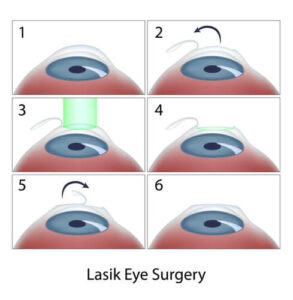Undergoing laser eye surgery to correct your vision can be truly life-changing. These procedures improve your vision and can eliminate the need for traditional glasses and contact lenses.
If you’ve heard of any laser eye surgery, you’ve probably heard of LASIK. But LASIK isn’t the only option out there. While popular, LASIK isn’t suitable for everyone.
There are a few options to choose from for laser eye surgery. It may seem difficult to choose, but you can easily narrow down your choices by looking at what each procedure accomplishes and who makes a good candidate for that particular procedure.
Here’s what you need to know about the vision correction options we offer here at New England Eye Center:
LASIK

LASIK is the most popular laser eye surgery for vision correction. It’s highly safe and effective, with over 95% of patients achieving 20/20 vision or better.
LASIK works by permanently reshaping the cornea. This corrects refractive errors when the cornea is no longer an irregular shape. These include nearsightedness, farsightedness, and astigmatism.
When you have a refractive error, it’s due to the shape of your cornea, which is the clear, front part of your eye that light passes through. When light passes through the cornea, it refracts before hitting your retina at the back of your eye.
Your retina sends information to your brain to process what you see as images. When you have a refractive error, the shape of your cornea doesn’t let light refract the right way through your eye, making the images you see blurry.
What Sets LASIK Apart
Laser eye surgeries like LASIK correct refractive errors by reshaping the cornea into shape to compensate for the error. LASIK is unique because of how it’s performed.

Instead of simply reshaping the cornea’s surface, a LASIK surgeon creates a flap in the cornea. The flap in the cornea involves making a small incision in the top and leaving a hinge to lift the flap.
After making the flap, the tissue under the cornea is then reshaped. Then the LASIK surgeon replaces the flap, so it acts as a bandage while the eye heals.
The flap will fuse back with the rest of the eye as it heals and doesn’t require any stitches to hold it in place. Not needing stitches helps keep LASIK recovery time quick and easy.
Most people with a refractive error make great candidates for LASIK surgery. The qualifications needed to be a good LASIK candidate include:
- Being at least 18 years old
- Being in good health
- Having no other eye conditions
- Having a stable prescription
You also need to have a cornea thick enough for a flap to be made. If your cornea is too thin, having a flap created is no longer safe.
However, if your cornea is too thin, which you can find out by getting a LASIK consultation, there are alternatives.
PRK
PRK is a laser eye surgery that is very similar to LASIK. It predates LASIK as the first-ever laser eye surgery. PRK is still performed today and is as effective as ever, with results just as good as LASIK and comparable after recovery.
The only difference between the two laser vision correction procedures is that PRK does not make a corneal flap. Instead, during PRK, the cornea is only reshaped after removing the thin, outermost layer of the cornea, called the epithelium.
PRK Results in Outcomes as Good as LASIK

The epithelium will regrow back on its own after a few weeks, which can cause some discomfort. During that time, PRK patients need to wear bandage contact lenses to protect their eyes as they heal.
Because PRK doesn’t require a corneal flap, patients with thin corneas can still make good PRK surgery candidates. The outcomes of PRK are just as good as the outcomes of LASIK, with most patients achieving 20/20 vision or better.
It takes longer to recover after PRK because the epithelium needs to regenerate. However, after recovering, patients end up with comparable visual results to LASIK. PRK is an excellent option for anyone with a refractive error who doesn’t qualify for LASIK. But there are still other options.
The Visian ICL
Unlike LASIK and PRK, the Visian ICL is not a laser vision procedure. Instead, the Visian ICL is an Implantable Collamer Lens.
The Visian ICL does not reshape the cornea in any way. It’s placed in the eye behind the natural lens and the iris, making it an additive lens.
The Visian ICL is like a contact lens that goes in your eye and never needs replacing. If you choose, you can have it removed at any time. It’s also helpful knowing that you can remove it if your prescription changes due to cataracts or presbyopia.
The Visian ICL is the Only Reversible Vision Correction Procedure

It’s a lower commitment than other forms of laser eye surgery correction. The Visian ICL also doesn’t require your corneas to be a certain thickness.
The procedure for implanting the Visian ICL is simple. Your surgeon will numb your eyes and then create a small incision in your eye. After making the incision, they will fold up the Visian ICL and push it into place through the incision.
The surgeon then unfolds the Visian ICL through the incision with tiny forceps to ensure correct positioning. The incision doesn’t need any stitches and heals on its own.
The Visian ICL can only correct nearsightedness and astigmatism, so it’s not for farsighted patients. But it can correct nearsightedness to an even greater degree than LASIK or PRK.
LASIK and PRK can only correct up to -12.00 diopters at the most, but the Visian ICL can correct up to -20.00 diopters! The Visian ICL also causes less post-surgical dry eye, which can be better if you’re already predisposed to dry eyes.
When it comes to vision correction surgery, LASIK is never a bad option if you make a good candidate. But PRK and the Visian ICL are also great options if LASIK isn’t right for you, either because you don’t qualify or you’d like other choices.
To find out which vision correction procedure is best for you, schedule a consultation at New England Eye Center in Boston, MA!
